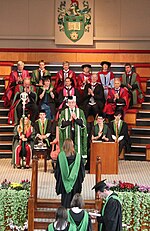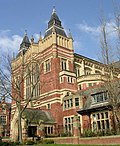
A red brick university was originally one of the nine civic universities founded in the major industrial cities of England in the 19th century.

The University of Leeds is a public research university in Leeds, West Yorkshire, England. It was established in 1874 as the Yorkshire College of Science. In 1884 it merged with the Leeds School of Medicine and was renamed Yorkshire College. It became part of the federal Victoria University in 1887, joining Owens College and University College Liverpool. In 1904 a royal charter was granted to the University of Leeds by King Edward VII.

Alfred Waterhouse was an English architect, particularly associated with the Victorian Gothic Revival architecture, although he designed using other architectural styles as well. He is perhaps best known for his designs for Manchester Town Hall and the Natural History Museum in London, although he also built a wide variety of other buildings throughout the country. Besides his most famous public buildings he designed other town halls, the Manchester Assize buildings—bombed in World War II—and the adjacent Strangeways Prison. He also designed several hospitals, the most architecturally interesting being the Royal Infirmary Liverpool and University College Hospital London. He was particularly active in designing buildings for universities, including both Oxford and Cambridge but also what became Liverpool, Manchester and Leeds universities. He designed many country houses, the most important being Eaton Hall in Cheshire, largely demolished in 1961-63. He designed several bank buildings and offices for insurance companies, most notably the Prudential Assurance Company. Although not a major church designer he produced several notable churches and chapels. He was both a member of The Royal Institute of British Architects, of which he served a term as President, and a Royal Academician, acting as Treasurer for the Royal Academy.

Hokie Stone is a grey dolomite—limestone rock found near Blacksburg, in western Virginia. It gets its name from the traditional nickname attributed to students and alumni of Virginia Tech.

The Victoria Building of the University of Liverpool, is on the corner of Brownlow Hill and Ashton Street, Liverpool, Merseyside, England. It is recorded in the National Heritage List for England as a designated Grade II listed building. It was designed by Alfred Waterhouse and completed in 1892. It was the first purpose-built building for what was to become the University of Liverpool, with accommodation for administration, teaching, common rooms and a library. The building was the inspiration for the term "red brick university" which was coined by Professor Edgar Allison Peers. In 2008 it was converted into the Victoria Gallery & Museum.

Millennium Square is a city square in the Civic Quarter of Leeds, West Yorkshire, England. It was Leeds's flagship project to mark the year 2000, and was jointly funded by Leeds City Council and the Millennium Commission. Total cost of production was £12 million.

Leeds General Infirmary, also known as the LGI, is a large teaching hospital based in the centre of Leeds, West Yorkshire, England, and is part of the Leeds Teaching Hospitals NHS Trust. Its previous name The General Infirmary at Leeds is still sometimes used.
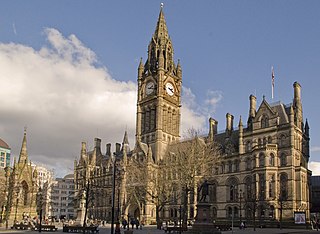
The architecture of Manchester demonstrates a rich variety of architectural styles. The city is a product of the Industrial Revolution and is known as the first modern, industrial city. Manchester is noted for its warehouses, railway viaducts, cotton mills and canals – remnants of its past when the city produced and traded goods. Manchester has minimal Georgian or medieval architecture to speak of and consequently has a vast array of 19th and early 20th-century architecture styles; examples include Palazzo, Neo-Gothic, Venetian Gothic, Edwardian baroque, Art Nouveau, Art Deco and the Neo-Classical.
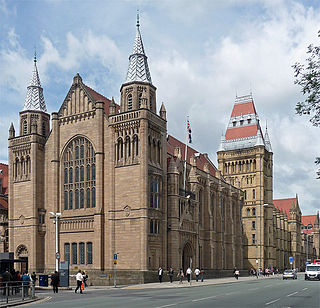
The Whitworth Building is a grade II* listed building on Oxford Road and Burlington Street in Chorlton-on-Medlock, Manchester, England. It has been listed since 18 December 1963 and is part of the University of Manchester. It lies at the south-east range of the old quadrangle of the University, with the Manchester Museum adjoined to the north, and the former Christie Library connected to the west.

The architecture of Leeds, a city and metropolitan borough in West Yorkshire, England, encompasses a wide range of architectural styles and notable buildings. As with most northern industrial centres, much of Leeds' prominent architecture is of the Victorian era. However, the City of Leeds also contains buildings from as early as the Middle Ages such as Kirkstall Abbey, one of Britain's best preserved ruined Cistercian monasteries, as well as examples of 20th century industrial architecture, particularly in the districts of Hunslet and Holbeck.
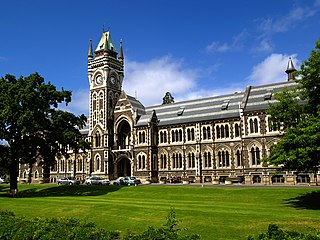
The University of Otago Clocktower complex is a group of architecturally and historically significant buildings in the center of the University of Otago campus. Founded in Dunedin, New Zealand, in 1869, the University of Otago was the expression of the province's Scottish founders' commitment to higher education. They were also the inheritors of a strong architectural tradition and gritty determination. Defending the decision to build inexpensive materials in an elaborate historicizing manner the Chancellor, Dr. D.M. Stuart, said "the Council had some old-world notions and liked to have a university with some architectural style". This attitude persisted for over fifty years and resulted in an impressive group of buildings.

The Prudential Assurance Building is a Grade II listed, Victorian Gothic revival style office building located on Dale Street in the centre of Liverpool, England.

High Victorian Gothic was an eclectic architectural style and movement during the mid-late 19th century. It is seen by architectural historians as either a sub-style of the broader Gothic Revival style, or a separate style in its own right.

The Brotherton Library is a 1936 Grade II listed Beaux-Arts building with some art deco fittings, located on the main campus of the University of Leeds. It was designed by the firm of Lanchester & Lodge, and is named after Edward Brotherton, 1st Baron Brotherton, who in 1927 donated £100,000 to the university as funding for its first purpose-built library.

Mill Hill Chapel is a Unitarian church in Leeds, West Yorkshire, England. It is a member of the General Assembly of Unitarian and Free Christian Churches, the umbrella organisation for British Unitarians. The building, which stands in the centre of the city on City Square, was granted Grade II* listed status in 1963.

Romanesque Revival, Norman Revival or Neo-Norman styles of building in the United Kingdom were inspired by the Romanesque architecture of the 11th and 12th centuries AD.


